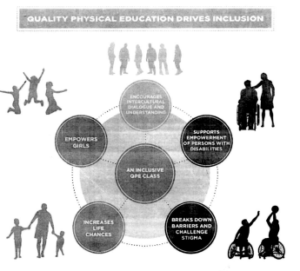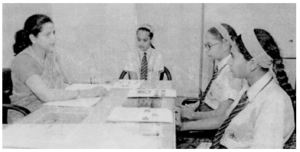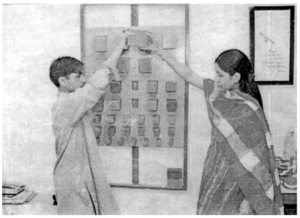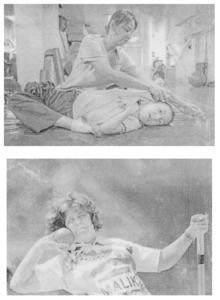Chapter – 4
Physical Education & Sports for Differently Abled
In this post, we have given the Important Questions of Class 11 Physical Education Chapter 4 (Physical Education & Sports for Differently Abled) in English. These Important Questions are useful for the students who are going to appear in class 11 board exams.
| Board | CBSE Board, UP Board, JAC Board, Bihar Board, HBSE Board, UBSE Board, PSEB Board, RBSE Board |
| Textbook | NCERT |
| Class | Class 11 |
| Subject | Physical Education |
| Chapter no. | Chapter 4 |
| Chapter Name | (Physical Education & Sports for Differently Abled) |
| Category | Class 11 Physical Education Important Questions in English |
| Medium | English |
Very Short Answer Type Questions
Q.1 What is adaptive physical education?
Ans. Through adaptive physical education, students are encouraged to participate in safe, satisfactory physical activities.
Q.2 What is integrated physical education?
Ans. Integrated physical education is a comprehensive concept, it is not only limited to physical activities, games, and sports but has become a complete discipline.
Q.3 What is inclusion?
Ans. Inclusion is not a favor we do for students with disabilities. Inclusion is a gift we give ourselves; the gift of understanding, the gift of knowing that we are all members of the human race and that joy comes in building genuine relationships with a range of other people.
Q.4 What do you mean by inclusion in physical education?
Ans. Inclusion in physical education means that students with disabilities participate in all activities equally with other students Students with disabilities learn the same curriculum content, with the same lesson objective, in the same space, and with the same assessment as all other students. Modifications are applied where needed.
Q.5 What are the two benefits of inclusive education?
Ans.
- Increase social skills.
- Increase motor skills.
- Increase friend skills.

Question for 3 Marks
Q.1 Write a short note on the origin of the Para Olympic Games.
Ans. During the second world war majority of people suffered. They lost their willpower and kept remembering the horrors of wars all the time. In1960 Rome Olympics, Sir Ludwig Collected 400 disabled Athletes and organized games and it was named Para Olympics. The shooting was the first game to be introduced in the Para Olympic games, the international Para Olympic committee is responsible for organizing the summer and winter Olympic games. The headquarter of IPC is situated in Bonn (Germany).
The symbol of the Para Olympic Games is three colors red, Blue, and green flag and the motto of Para Olympic is ‘Spirit in Motion’ 2014 winter para Olympic games were successfully hosted by Russia.
Q.2 Describe the principles of integrated and comprehensive physical education.
Ans.
- It should be based on the interrelated sub-topics of physical education.
- It should cater to the requirements of different people.
- It should be capable of facing the challenges of the present and the future.
- It should be capable of providing comprehensive and deep knowledge about physical education.
- It should motivate an individual to engage in a lifelong healthy and active lifestyle.
- It should be able to develop social and emotional skills among people
Q.3 Write a note on the special Olympic Bharat.
Ans. This organization was established in 2001, its aim is to increase the participation of differently-abled persons in games and sports. Its other objective was to develop leadership quality and healthy. This organization organizes sports competitions at the state level. It also serves talented players and trains them for international games. After 2002, about 23,750 participants participated in national games. Between 1987 and 2013, a total of 671 Indian athletes participated in Olympics. They won 246 Gold medals, 265 Silver medals, and 27 bronze medals and they raised the glory of the country in the world. Today around 1 million athletes are members of this organization and
84905 coaches train these athletes. This organization does the all-around development of the players through games and sports.
Q.4 How can we implement inclusive education in physical education?
Ans. PEER TO PEER: EVERYONE’S A PLAYER, EVERYONE’S A LEADER
Special Olympics believes in the power of sport and in the power of young people to build a more inclusive world. In a high-quality Inclusive Physical Education classroom, students recognize their abilities to create inclusive communities as they learn to value difference and appreciate each individual’s unique gifts and talents.
Peer-to-peer leaching is a fundamental strategy for implementing successful Inclusive Physical Education programs, but it is important that it be implemented in a truly inclusive manner and grounded in equality. An inclusive peer-to-peer teaching model provides opportunities for students
of all abilities to participate as leaders in some way, reinforcing and confirming the potential of every student to lead and contribute meaningfully.
Question for 5 Mark
Q.1 Which principles are required to be followed to make the adapted physical education effective? Explain.
Ans.
- Medical Examination:- It is very important for the success of programs related to dated physical education. Otherwise, it will be difficult to find out what kind of disability, the student is suffering from. Therefore it is imperative to conduct medical examinations of the students.
- Programs according to the interest of the students:- programs should be made keeping in mind the interest, capacity, and previous experience of the students. The teachers should also have deep knowledge about it, then only they can make any successful program.
- Equipment should be appropriate:- Students should be provided with equipment as per the disability concerned, for example, students suffering from visual impairment should be given a ball with a bell so that they may catch the ball as it rolls because of the sound. Thus such students can make out. The direction and distance of the ball.
- Proper Environment:- The play area also should be limited because of the limited speed capacity of the children, for example, speech impaired children are given rest in between the games. The play area should be limited to top smaller area.
- Modification of rules:- Rules and regulations of the game and sports should be modified depending on the specific needs of students. In order to learn new skills, they may be given extra time, extra effort, extra rest, and 2 marks in place of 1 mark. Thus, they might be given the opportunity for all-around development.
Q.2 Explain the concept of Inclusion.
Ans. A defining characteristic of an excellent physical education program is that it includes students with a diverse range of abilities, needs, interests, and learning styles in meaningful learning experiences. The term “Inclusive Physical Education” reflects a program where respect and acceptance of all students, specifical students with disabilities, is an essential component of the
classroom environment and teaching strategies.
Inclusion is about creating a classroom in which every student is welcomed, valued, respected, and enabled to reach his or her full potential. In a successful Inclusive Physical Education program, all students are fully engaged in instructional activities, sharing equally and learning together. Although the activities may be modified or adapted, students with disabilities learn the same
concepts, skills, and content as all other students in the class. The result is educational equity and access for all students!
Inclusive Physical Education requires educators to believe in the concept that success for each student can be different The educator must be willing to modify and adapt lessons and activities to ensure that every student learns and achieves success at his own pace and according to his own abilities. Educators see the abilities of all students as contributing to the whole class. Effective
teaching for students with disabilities is basically the same as effective teaching for all students.
Q.3 What is the role of the school counselor in special education?
Ans.
- The role of a school counselor is to help all students, including those with special needs, to achieve their full potential. Introducing an appropriate individualized education program (IEP) at an early age can make all the difference, not only in these children’s academic learning
but in their emotional health and social adjustment and ultimately in their ability to become productive, contributing member of society. - Counseling sessions with special education students.
- Encouraging family involvement in IEP.
- Counseling with and working with other school staff to better understand the child’s special needs.
- Collaborating with other school and community professionals like, teachers, school, psychologists, physical therapists, occupational therapists, etc.
- Identifying other students who should be assessed to determine their eligibility for special education.

Q.4 What is the need for inclusion in physical education?
Ans. Inclusion is needed for the following reasons—
- Inclusion in physical education increases the social skills of students with disabilities.
- Inclusion is needed to increase the motor skills of students with disabilities.
- Disabled student gets an equal chance to participate in age-appropriate activities, which increases their confidence level.
- Typical students get a chance to increase friendships with disabled children.
- Inclusive education provides an opportunity for typical students to go beyond tolerance to acceptance and advocacy.
- Inclusive education enables a student to increase their knowledge and acceptance based on the “contact theory”. Through frequent, meaningful, and pleasant interactions, changes in attitude can occur.
What is the role of an occupational therapist for special needs children?
- Self-care – An occupational therapist will help a child perform and be independent in self-care skills like eating, dressing, toileting, bathing, and grooming.
- Play – An occupational therapist helps children participate and interact with others in play. They may suggest modifying cations in the position, mobility aids, or modified toys to help a child play.
- School – Occupational therapists help children participate and accept regular school. They may suggest aids for writing and other classroom activities help them participate equally with other children. Children with special needs may also require special furniture to help them sit and write better.
- Environmental modifications: Occupational therapists can suggest modifications in the house, school, or playground that will help the child participate more easily. Helping the child become independent early in life, will encourage them to live independently as an adult.
- Fine motor skills and Handwriting occupational therapists also play a role in helping a child improve their fine motor skills and handwriting. They will be able to identify the specific deficits in the child and suggest activities that will help improve these skills.
- Splinting – Occupational & learapists can also make simple splints to help the child perform activities in a better way.

- Pediatric treatment – Physiotherapy can be used to treat children affected by ‘Muscular Dystrophy’. These and other conditions may require the child to have help to improve balance, strength, and coordination.
Techniques of Physiotherapy
1. Massage and manipulation
2. Exercise and movement
3. Electrotherapy
4. Hydrotherapy

Q.5. What is the contribution of special education teachers in developing education plans for special needs children?
Ans.
- Assess students’ skills to determine their needs and develop teaching plans.
- Adapt lessons to meet the needs of students.
- Develop Individualised education programs (IEPs) for students.
- Plan, organize, and assign activities that are specific to each student’s ability.
- Implement IEPs, and assess students.
- Update IEPs throughout the school year to reflect students’ progress and goals.
Q.6. What is the role of a physical education teacher for children with special needs?
Ans.
- The rights of persons with disabilities Act 2016, gives pupils a right to inclusive activity. So physical education teachers are expected to take action within the individual school context and modify and adapt existing practices in order to facilitate full entitlement to access to physical activity for pupils with special needs.
- The PETs organize ball games for disabled children to improve overall strength and agility hand-eye coordination and gross motor skills. Students have shown that throwing, catching, rolling, and passing the ball improves the disabled child’s muscle response.
- Scientific research has demonstrated that physical education can enhance academic performance and cognitive function. So parents with the help of teachers should always encourage the child with special needs to participate in activities.
- Physical education teachers need to determine the abilities of students with special needs so that to design special sports activities according to their needs.
- Speech Fluency/Stuttering: Stuttering is a communication disorder that affects speech fluency. Therapists can teach the child strategies on how to control behavior like tension in the
neck, shows, face, jaw, chest, eye blink, etc. and thus increasing lies speech fluency and intelligibility. - Voice and Resonance: Voice disorders refer to disorders that affect the vocal folds that allow us to have a voice. These can include vocal cord paralysis, nodules, or polyps on vocal folds. Therapists can work with children to decrease these behaviors (vocal classes) and repair the strain/damage of the folds.
Q.7. What is the role of a speech-language pathologist for special needs children?
Ans. Speech therapist/pathologist works with children with a variety of delay and disorder such as autism. Down syndrome, hearing impairment, motor speech disorders, and other developmental delays.
They help children with:
- Articulation skills/speech integrity articulation is the physical ability to move the tongue, lips, jaw, and palate (known as the articulators) to produce individual speech sounds which we phonemes.
- Expressive Language Skills While speech involves the physical motor disability to talk, language is a symbolic system used to convey a message. Proper use of these is developed by speech
therapist. - Receptive Language/Listening Skills Receptive language refers to a child’s ability to listen and understand language. A therapist can help teach the child new vocabulary and how to use that
knowledge to follow directions, answer questions and participate in single conversations with others. - Physiotherapists – Physiotherapists are trained to evaluate and improve the function of the body, with particular attention to physical mobility, balance, posture, fatigue, and pain.
- The physical therapy program involves educating the child about the physical problems caused by their disability, designing an individualized wise program to address the problems, and enhancing mobility and energy conservation through the use of a variety of mobility aids and adaptive equipment.
- Physiotherapy can be used to help children who have neurological condition that affects the nervous system, such as multiple sclerosis, stroke, and cerebral palsy. Physiotherapy can be used to treat injuries that affect the bone, joints, and muscles such as sports injuries and arthritis.
We hope that Class 11 Physical Education Chapter 4 (Physical Education & Sports for Differently Abled) Important Questions in English helped you. If you have any queries about class 11 Physical Education Chapter 4 (Physical Education & Sports for Differently Abled) Important Questions in English or about any other notes of class 11 Physical Education in English, so you can comment below. We will reach you as soon as possible…